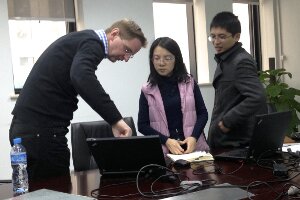 Individual motorised transport in Beijing has increased strongly over the last years. In order to identify appropriate measures to minimise air pollution, congestion and global emissions, the Transport Demand Management Project developed a model to quantify transport related emissions.
Individual motorised transport in Beijing has increased strongly over the last years. In order to identify appropriate measures to minimise air pollution, congestion and global emissions, the Transport Demand Management Project developed a model to quantify transport related emissions.
China’s economic growth over the last three decades has had numerous positive effects, but it has also led to a tremendous increase of individual motorised transport. In Beijing, the stock of 5 million cars increases air pollution, congestion, parking problems as well as the number of accidents. The strong growth of individual motorised transport and its negative effects, including rising GHG emissions, have become a growing challenge for Beijing and other large cities in China.
In order to assess the emissions impact in Beijing, GIZ, its partners at the Beijing Transportation Research Center (BTRC), and the Swiss INFRAS Institute developed an emission modelling database and model to quantify GHG emissions from road transport in Chinese cities – the China Handbook for Emissions Factors. In a joint approach international and local experts adapted the European Handbook of Emission Factors for Road Transport (HBEFA ) to Chinese traffic realities. Analysing typical driving cycles in Beijing and Shenzhen and calculating the resulting emissions, using the PHEM model, the team established a first version of a detailed Chinese emission factor database. The database provides emission factors differentiated by vehicle category, road type and level of service (LOS). The four categories of traffic situations (levels of service) traditionally used in Europe were complemented by a fifth level, capturing the heavy stop-and-go situations occurring in many Chinese cities. This is not trivial, as the amount of emissions from heavy stop-and-go traffic can be up to one-third higher than those of normal stop-and-go traffic, depending on the type of road. The now available China Handbook for Emissions Factors (CHEF-Model) provides a uniform interface by integrating the Chinese emission factor database, source transport activity and fleet composition. The underlying bottom-up approach of the tool provides detailed data on GHG emissions by mode, vehicle type, trip purpose, and fuel type and thereby allows the evaluation of policies and measures. The model also includes air pollutant emissions, but, these still need to be calibrated to the Chinese context.
The detailed emission factors now serve as a basis to develop aggregated default values based on approximations of local levels of service. Aggregated values can then be used in cities, which lack the information for detailed emission calculations based on a detailed road network. GIZ and its partners are developing a set of Chinese average emission factors for small, medium, and large cities to be incorporated as default values into the CHEF-Model.
The localised emission factor database enables Chinese cities to quantify transport related GHG emissions as well as to model the impacts of potential traffic restricting policies. It provides a practical approach to assess emissions by considering the existing data availability and providing default values where local data is missing. Outputs can improve Chinese GHG emissions inventories for transport and enable better decision-making on appropriate mitigation strategies. Furthermore, the Chinese approach can be transferred to other cities or countries focusing on transport related emission modelling.
- Learn more about the approach of adapting HBEFA emission factors to the local context here:
 Adaption of HBEFA Emission Factors for Road Transport for Chinese Cities 2.87 MB
Adaption of HBEFA Emission Factors for Road Transport for Chinese Cities 2.87 MB - Read more about transport emission modelling and GHG accounting on our TDM project website.



One thought on “European Handbook on Emission Factors for Road Transport now Adapted to China”